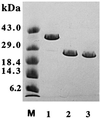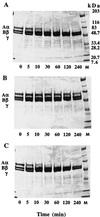Fibrinogen cleavage by the Streptococcus pyogenes extracellular cysteine protease and generation of antibodies that inhibit enzyme proteolytic activity
- PMID: 10456870
- PMCID: PMC96748
- DOI: 10.1128/IAI.67.9.4326-4333.1999
Fibrinogen cleavage by the Streptococcus pyogenes extracellular cysteine protease and generation of antibodies that inhibit enzyme proteolytic activity
Abstract
The extracellular cysteine protease from Streptococcus pyogenes is a virulence factor that plays a significant role in host-pathogen interaction. Streptococcal protease is expressed as an inactive 40-kDa precursor that is autocatalytically converted into a 28-kDa mature (active) enzyme. Replacement of the single cysteine residue involved in formation of the enzyme active site with serine (C192S mutation) abolished detectable proteolytic activity and eliminated autocatalytic processing of zymogen to the mature form. In the present study, we investigated activity of the wild-type (wt) streptococcal protease toward human fibrinogen and bovine casein. The former is involved in blood coagulation, wound healing, and other aspects of hemostasis. Treatment with streptococcal protease resulted in degradation of the COOH-terminal region of fibrinogen alpha chain, indicating that fibrinogen may serve as an important substrate for this enzyme during the course of human infection. Polyclonal antibodies generated against recombinant 40- and 28-kDa (r40- and r28-kDa) forms of the C192S streptococcal protease mutant exhibited high enzyme-linked immunosorbent assay titers but demonstrated different inhibition activities toward proteolytic action of the wt enzyme. Activity of the wt protease was readily inhibited when the reaction was carried out in the presence of antibodies generated against r28-kDa C192S mutant. Antibodies produced against r40-kDa C192S mutant had no significant effect on proteolysis. These data suggest that the presence of the NH(2)-terminal prosegment prevents generation of functionally active antibodies and indicate that inhibition activity of antibodies most likely depends on their ability to bind the active-site region epitope(s) of the protein.
Figures






Similar articles
-
Expression and characterization of group A Streptococcus extracellular cysteine protease recombinant mutant proteins and documentation of seroconversion during human invasive disease episodes.Infect Immun. 1998 Feb;66(2):765-70. doi: 10.1128/IAI.66.2.765-770.1998. Infect Immun. 1998. PMID: 9453639 Free PMC article.
-
Substitution of cysteine 192 in a highly conserved Streptococcus pyogenes extracellular cysteine protease (interleukin 1beta convertase) alters proteolytic activity and ablates zymogen processing.Infect Immun. 1996 Jun;64(6):1913-7. doi: 10.1128/iai.64.6.1913-1917.1996. Infect Immun. 1996. PMID: 8675287 Free PMC article.
-
Replacement of histidine 340 with alanine inactivates the group A Streptococcus extracellular cysteine protease virulence factor.Infect Immun. 2000 Jun;68(6):3716-9. doi: 10.1128/IAI.68.6.3716-3719.2000. Infect Immun. 2000. PMID: 10816533 Free PMC article.
-
Structure-function and pathogenesis studies of Streptococcus pyogenes extracellular cysteine protease.Adv Exp Med Biol. 1997;418:589-92. doi: 10.1007/978-1-4899-1825-3_136. Adv Exp Med Biol. 1997. PMID: 9331720
-
IdeS and SpeB: immunoglobulin-degrading cysteine proteinases of Streptococcus pyogenes.Curr Opin Microbiol. 2003 Feb;6(1):50-5. doi: 10.1016/s1369-5274(03)00003-1. Curr Opin Microbiol. 2003. PMID: 12615219 Review.
Cited by
-
Mutational studies on HslU and its docking mode with HslV.Proc Natl Acad Sci U S A. 2000 Dec 19;97(26):14103-8. doi: 10.1073/pnas.250491797. Proc Natl Acad Sci U S A. 2000. PMID: 11114186 Free PMC article.
-
Determining antibody-binding site of streptococcal pyrogenic exotoxin B to protect mice from group a streptococcus infection.PLoS One. 2013;8(1):e55028. doi: 10.1371/journal.pone.0055028. Epub 2013 Jan 31. PLoS One. 2013. PMID: 23383045 Free PMC article.
-
Proteolytic Profiling of Streptococcal Pyrogenic Exotoxin B (SpeB) by Complementary HPLC-MS Approaches.Int J Mol Sci. 2021 Dec 30;23(1):412. doi: 10.3390/ijms23010412. Int J Mol Sci. 2021. PMID: 35008838 Free PMC article.
-
The Streptococcus pyogenes signaling peptide SpoV regulates streptolysin O and enhances survival in murine blood.J Bacteriol. 2021 Jun 1;203(11):e00586-20. doi: 10.1128/JB.00586-20. Epub 2021 Mar 15. J Bacteriol. 2021. PMID: 33722844 Free PMC article.
-
SpeB of Streptococcus pyogenes differentially modulates antibacterial and receptor activating properties of human chemokines.PLoS One. 2009;4(3):e4769. doi: 10.1371/journal.pone.0004769. Epub 2009 Mar 10. PLoS One. 2009. PMID: 19274094 Free PMC article.
References
-
- Bilezikian S B, Nossel H L. Unique pattern of fibrinogen cleavage by human leukocyte proteases. Blood. 1977;50:21–28. - PubMed
-
- Corbett S A, Lee L, Wilson C L, Schwarzbauer J E. Covalent cross-linking of fibronectin to fibrin is required for maximal cell adhesion to a fibronectin-fibrin matrix. J Biol Chem. 1997;272:24999–25005. - PubMed
-
- Cottrell B A, Strong D D, Watt K W K, Doolittle R F. Amino acid sequence studies on the α chain of human fibrinogen. Exact location of cross-linking acceptor sites. Biochemistry. 1979;18:5405–5410. - PubMed
Publication types
MeSH terms
Substances
Grants and funding
LinkOut - more resources
Full Text Sources
Other Literature Sources

